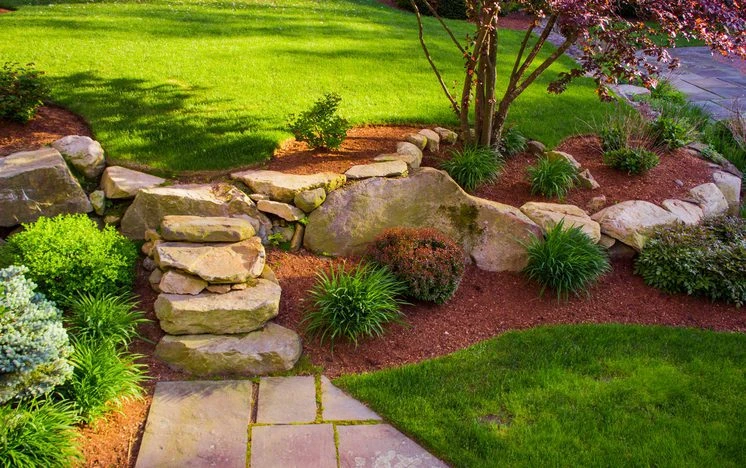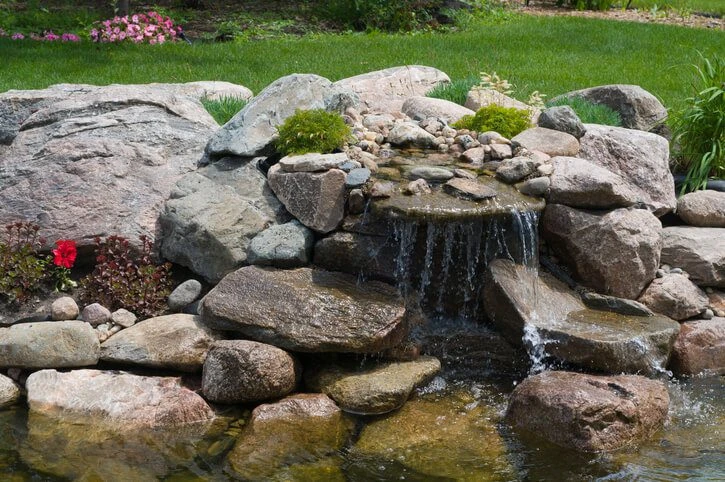Rockeries and rock features in gardens make wonderful backyard additions. They add a beautiful, clean, and organized aesthetic to any space — making them a desired home improvement. If you have limited backyard space, adding a small rockery design can do wonders in helping your backyard look and feel much larger than it is.
If you have always wanted to add a rockery to your backyard but have put it off because you think it will clutter the little space you have, that will not be an issue! There are countless rockery and rock garden designs curated for small backyards. By working with a rockery professional, you can learn what rockery design features are perfect for your small garden.

In the meantime, here are 7 of our best small rockery design tips to get you started on beautifying your garden.
1. Find the Perfect Location to Build Your Rockery
This is the first step when it comes to rockery design and improving your backyard. Before beginning to build your small rockery, you need to look over your backyard and decide where you would like to build it. If you are going for a rock garden, you may want to put it towards the rear or to one side of your backyard. However, you’ll want to consider front or center locations if you want to add a rock fire pit or water feature.
By taking the time to find the perfect location for your rockery design, you can make sure that your garden will be able to successfully highlight features of your yard. After all, you don’t want to start building a small rockery in your garden that won’t fit properly in that corner of the yard or begin installing a firepit where the yard floods during the summer.
2. Determine Your Aesthetic Preferences
What is your style? Chances are, your home reflects your aesthetic preferences and style extremely well. In a similar way, your backyard garden should also reflect your style. Determining your likes and dislikes will help you avoid wasted time and lost money and will also ensure that you end up with a beautiful rock garden that you are proud of.
Spend some time determining your style and figuring out your aesthetic preferences for your backyard. One way to do this is to look at photos of other small gardens with rockeries and take note of what rockery designs and features you like and don’t like.
3. What Types of Rock are Best for Your Small Rockery?
It’s important to consider what kinds of rock you want to use in your rockery design. If you are hoping to install a vintage themed rockery design for your small garden, then you should use rocks that are softer and more porous. This will help your rockery achieve that aged, weathered look much quicker.
On the contrary, harder, less porous rocks maintain their “new” appearance much longer. You don’t want these kinds of rock in a vintage garden, but do want them in a modern-styled rockery.
4. Make the First Sketch
Once you have found the location where you will put your small rockery and you’ve determined your aesthetic preferences, take a day or two to draw up the first sketch. Something that might help you during the sketching process is looking up other rockery designs online.
Sketching it out will help you make sure that the rockery design you see in your head will look good in your backyard.
5. Use Different Shapes, Sizes, & Elements
If you are looking for a way to add natural beauty to your small backyard, you might be surprised at how easy it is to do. Utilizing different natural elements in your small backyard rockery will give your space a unique, creative look and feel. You can achieve this by implementing rocks, bark, and ground cover plants in your small rockery design. Remembering to add these kinds of elements will give you access to a whole new range of colors and textures.
If you love spending time in nature or simply want to spruce up your small backyard, be sure to implement many different sized elements with color and texture to add an earthy, artistic look.
6. Use Rockeries to add a Focal Point
Does your yard lack a focal point? The wonderful thing about rockeries is that they can easily be used as a means to add a focal point to your small backyard.
You can do this by adding a prominent water feature to the center of your garden or using a boulder to draw the visitor’s eye.

Adding a rockery focal point to your small backyard can make such an immediate difference and can help your yard feel very intentional and cohesive.
7. Contact our Team of Professional Landscapers Today!
Adding a small rockery that reflects your personal style will compliment your backyard and give your home a feeling of completeness. Such a big endeavor should not be undertaken alone. By working with a professional landscape contractor you can ensure that your rockery design is properly installed.
New Life Rockeries has been serving Pacific Northwest homeowners for more than 30 years. We specialize in rockeries and landscape design and would love to help you improve your outdoor aesthetic.
If you would like to add a rockery design to your small garden, contact us today to speak with one of our rockery professionals. We’d be happy to answer any of the questions you may have about our services or provide you with a quote for your backyard project.
